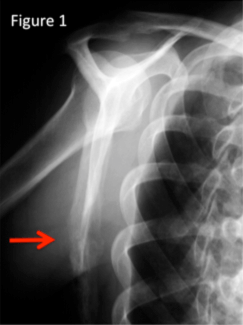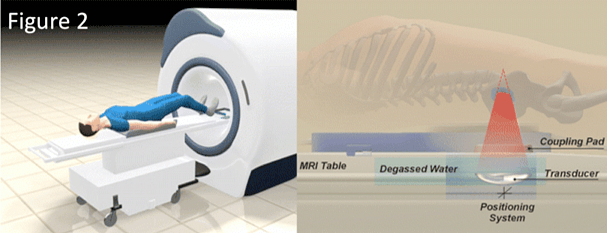Non-invasive Treatment for Pain Related to Bone Metastases
Magnetic Resonance-guided Focused Ultrasound (MRgFUS)

An FDA-approved treatment for pain related to bone metastases using Magnetic Resonance-guided Focused Ultrasound or MRgFUS. The treatment provides relief from tumor-related bone pain. The procedure is non-invasive and is performed with a nerve block and sedation.
MRgFUS uses an MRI thermal imaging system to continuously measure temperature changes inside the body, pinpointing and guiding the treatment.
The treatment is also called HIFU, which stands for High Intensity Focused Ultrasound.
Pain Related to Bone Metastases
After the lungs and the liver, bone is the third most common organ affected by metastatic disease. Pain related to bone metastases can substantially lower patients’ quality of life. Patients with prostate and breast cancer in particular can suffer for years from pain and disability caused by bone metastases.
Radiation therapy is currently considered the standard treatment for pain from bone metastases. Previous studies, however, have shown that approximately 20 to 30 percent of patients treated with radiation therapy do not experience pain relief. Depending on the radiation therapy protocol, options for retreatment may be limited. Alternatively, patients can be treated with narcotic medications, but those medications may lead to malaise, mental status changes, nausea, and constipation.
Relieving Pain in Bone Metastases Using MRgFUS
MRgFUS is performed on an outpatient basis so that patients can return to normal activities within a few days. The procedure is performed with the patient lying on the stomach or on the back in an MRI scanner for three to five hours under conscious sedation. An ultrasound probe is located under or over the site of the bone metastasis, and a water bath or gel is used to maximize acoustic contact between the skin and the ultrasound transducer. While the patient may feel some pain during the procedure, it should only be mild, and an anesthesiologist will administer medications to make the patient feel as comfortable as possible throughout the procedure.
The ultrasound probe generates high intensity waves that focus on the bone metastasis and cause the temperature in the bone and metastasis to rise. The result is cellular death in the area of the focused ultrasound, which effectively inactivates the nerve endings that generate the pain. During the procedure the temperature is constantly measured and the treated area is carefully monitored.
After the procedure the patient is moved to the recovery area, where nurses provide care for approximately one to two hours until the patient is ready to go home.

Figure 2 shows the set-up for a MRgFUS bone metastasis treatment with the patient lying on the ultrasound probe (Courtesy Insightec, Inc).
Benefits and Expected Results
Most patients report a decrease in their pain within one or two days after MRgFUS. It has been shown that in addition to pain relief, patients also frequently experience an improved quality of life.
MRgFUS offers the following additional benefits:
- It can be used when radiation therapy fails.
- No overnight hospital stay is required, and usually only one treatment is required for one bone metastasis.
- MR-guided focused ultrasound is a completely non-invasive procedure, meaning there is no surgery, no incision, and no blood loss.
- The patient can return to normal activities within a few days.
Clinical Research Trials
A Feasibility Study to Evaluate the Safety and Initial Effectiveness of ExAblate MR Guided Focused Ultrasound Surgery in the Treatment of Pain Resulting from Metastatic Bone Tumors with the ExAblate 2100 Conformal Bone System
The purpose of this study is to evaluate the safety and effectiveness of the ExAblate MR-guided Focused UltraSound (MRgFUS) device for the treatment of metastatic bone pain. All eligible patients who choose to participate will receive the MRgFUS treatment for reduction of their metastatic bone pain. This study will require four outpatient visits to the UCSF Imaging Center and four telephone visits over a period of 3 to 4 months. Patients will be followed for 3 months after their treatment.
The MRgFUS treatment is a non-invasive procedure that uses focused ultrasound waves to destroy the pain-transmitting nerves in the bone surface surrounding the tumor. The ultrasound waves destroy the nerves by generating heat. The Magnetic Resonance Imaging (MRI) is used to visualize the tumor and surrounding tissues and monitor temperature during the procedure.
For more information, please call (415) 514-8987 or email [email protected].
Sponsor: InSightec, Inc.
Principle investigator: Thomas Link, MD, PhD
Other Investigators: K. Pallav Kolli, MD and Matthew Bucknor, MD
ClinicalTrials.gov Identifier: NCT00981578.
Related Content
Make an Appointment
(415) 353-2573
Consultation Contact
Matthew Bucknor, MD
Associate Professor
Pallav Kolli, MD
Associate Professor
Thomas Link, MD, PhD
Professor

Matthew Bucknor, MD
